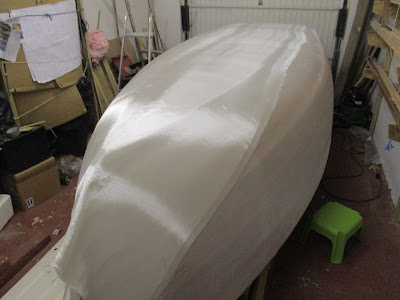Do you remember Hans Christian Anderson's story of the Emperor's new clothes? For those who don't: The emperor is scammed into buying an invisible set of clothes; the salesman convinces the emperor that only intelligent people can see the clothes. The Emperor parades in the nude whist everyone congratulates him on buying such a wonderful set of clothes.
Seagull, antithetically (my favourite word which means in contrast) starts off with a very visible set of clothes ... which slowly disappear, albeit they are still there. How this happens is rather difficult to explain, but I owe an explanation to my dear friends, Julie the painter/tutor/genius and Lynne the writer/tutor/genius, both were worried (see last post comments) that we would lose the rich colour of the planking.
Because boats are always female, when I dressed Seagull, the analogy that comes to mind is a wedding dress.
As you can see, the beauty of the wood seems to be hidden. Before I explain to you the process you're about to witness, let me set the scene.
1. The planks are made from Red Cedar because it is knot-free, has a lovely finish when varnished, and bends easily without splitting. The downside is that it marks easily if bumped - in the way boats do - and water eats it alive. So if I could cover it in something that gives it strength and stops it coming into contact with water then I would... and that's exactly what I am doing: Woven Fibre Glass Cloth is the material I am using to sheath Seagull both outside and in.
2. Epoxy Resin is basically a glue, which I used earlier in this blog, and it is this that I shall use to stick the wedding dress onto the boat.
I push the yellow handle on tin 105 down and it delivers five portions of the resin into the tub at the front of the photograph. I then push down the handle of the smaller tin marked 205 and it delivers 1 portion of hardener in the tub. I then stir the concoction for 2 minutes until it is fully blended. The mixture has a working life of about 20-30 minutes during which time it gets hotter and hotter ... one can't hang around. I then pour it onto the fibre glass and I use a paint roller and plastic 'scraper' to spread it over the wedding dress.
It isn't as easy a process as it sounds: the cloth wants to move and make wrinkles and 'snags' as easily as ladies tights (so I'm 'er told).
It's surprising how long this takes to do: one side and the transom (back end) took most of the day.
There will be two further coats after this one. Besides being a glue, epoxy and the fibre glass set into a steel like coat that brings both strength and a resistance to surface damage. Finally, the resin sets like a very shiny varnish.






Ooh, magic :-)
ReplyDeleteNothing up my sleeves....!
ReplyDeleteAbsolutely fascination...who ever would have guessed the material would become transparent like that. The beauty of the wood is BAAACK!
ReplyDeleteDon't look now but I think things may be about to go pear-shaped!!!
ReplyDeleteHello John!:) The rich colour of the wood is truly beautiful, and the procedure that you did covering the Ceder Wood took great patience. I had never heard of Woven Fibre Glass Cloth before today, so thank you for explaining the procedure, and with this protection, may Seagull have a long and sea worthy life.:)
ReplyDeleteHello Sonjia. Thank you for your comment. The cloth is a bit of a nightmare to use, could have done with some of your hornets with their architectural skill.
ReplyDelete